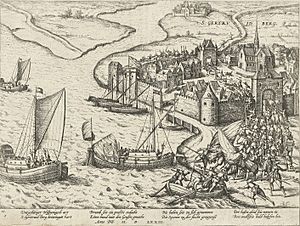Capture of Geertruidenberg (1573) facts for kids
Quick facts for kids Capture of Gertruidenberg (1573) |
|||||||
|---|---|---|---|---|---|---|---|
| Part of the Eighty Years' War & the Anglo-Spanish War (1585–1604) | |||||||
 Capture of Geertruidenberg, 1573 Etching by Frans Hogenberg |
|||||||
|
|||||||
| Belligerents | |||||||
| Commanders and leaders | |||||||
| Strength | |||||||
| 300 | 170 | ||||||
| Casualties and losses | |||||||
| 4 killed | Most killed | ||||||
The Capture of Geertruidenberg was an important military event. It happened on August 28, 1573, during the Eighty Years' War and the Anglo–Spanish War. Soldiers from England, France (called Huguenots), and Flanders worked together. They were led by Colonel de Poyet. A small group of attackers, led by Walter Morgan, captured the main gate. This surprised the soldiers defending the city, and most of them were killed.
Contents
Key Events of the Capture
Why Geertruidenberg Was Captured
The Spanish city of Middelburg was under attack. It needed help from Spanish ships. However, a group known as the Sea Beggars stopped these ships. They won a battle in April near Zeeland.
Another Spanish rescue attempt was also turned back. This happened after Fort Rammekens gave up to English and Rebel forces in August. Because of these victories, the Sea Beggars' ships could meet with Prince of Orange. They met in Dordrecht.
A small group of 300 soldiers was then sent out. These soldiers were from England, Scotland, France (Huguenots), and Flanders. Their leader was Lieutenant Colonel de Poyet. Their goal was to capture the city of Geertruidenberg. The ships sailed quietly towards the city at night.
The city of Geertruidenberg was defended by 170 soldiers. They were called Walloons and were led by Captain Draek. The Protestant force landed at night in North Brabant. They then moved closer to the city.
How the City Was Taken
In the early morning of August 31, 1573, Colonel de Poyet gave an order. He told Walter Morgan and Captain Malion, a Frenchman, to lead eighteen chosen soldiers. Four of these soldiers had lived in Geertruidenberg. Their mission was to climb the city's walls. They needed to open the Breda Gate.
Opening this gate was key to taking the city. It would allow the main force to attack quickly and by surprise. The small group climbed the walls without being seen. They quietly dealt with the sleeping guards. Then, they opened the gate for the main army.
The defending soldiers only realized the city was under attack when it was too late. They were completely surprised. They tried to fight back, but most were killed. Only a few managed to escape, including Captain Draek. He was wounded but got away through a back window. In his hurry, he left all his men's pay on a table. The attackers were very happy to find it.
The people living in the city were mostly treated well. An English soldier later said that this was the first city captured in over a year. It greatly boosted the confidence of the Protestant forces. The few soldiers who escaped, like Captain Draek, fled to Breda.
What Happened Next
After new soldiers were placed in Geertruidenberg, Poyet and Morgan went back to Dordrecht. The Prince of Orange chose Jerome Tseraarts to lead the soldiers in Geertruidenberg. He trusted him a lot. On September 8, the first Protestant church service was held in the city.
Geertruidenberg stayed in the hands of the Dutch until April 1589. At that time, an English and Dutch group of soldiers, led by John Wingfield, gave it up to the Spanish. This happened under the Duke of Parma.
However, the Spanish didn't keep the city for long. On June 25, 1593, after a siege, the city was back in Dutch hands permanently.

